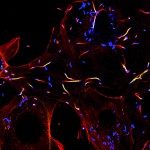Lien vers Pubmed [PMID] – 14630831
Blood 2004 Mar;103(6):2397-400
Sickle cell vaso-occlusion is a complex multistep process likely involving heterotypic interactions among sickle erythrocytes (red blood cells [RBCs]), leukocytes (white blood cells [WBCs]), and endothelial cells. Recent data using intravital microscopy in a sickle cell mouse model suggest that adherent leukocytes in postcapillary venules play a critical role in vaso-occlusion by capturing circulating sickle RBCs. In the course of studies to investigate the adhesion receptors mediating sickle RBC-WBC interactions, we found that control nonspecific immunoglobulin G (IgG) preparations displayed significant inhibitory activity. As a result, we studied the effects of commercial intravenous human immune globulin (i.v.IG) preparations and found that i.v.IG inhibits RBC-WBC interactions in cremasteric venules in a dose-dependent manner. i.v.IG of at least 200 mg/kg dramatically reduced these interactions, even after tumor necrosis factor-alpha (TNF-alpha) stimulation, and not only increased microcirculatory blood flow but also improved survival of sickle cell mice. These data raise the possibility that i.v.IG may have a beneficial effect on sickle cell-associated vaso-occlusion.
